|
|
 |
Pierre Bonnard
|
|
French Nabi Painter, 1867-1947
French painter, printmaker and photographer. He is known particularly for the decorative qualities of his paintings and his individual use of colour. During his life he was associated with other artists, Edouard Vuillard being a good friend |
|
 |
Pierre de Valenciennes
|
|
Toulouse 1750-Paris 1819
.French painter. He trained at the academy in Toulouse under the history painter Jean-Baptiste Despax (1709-73). In 1769 he went to Italy for the first time, with Mathias Du Bourg, a councillor at the Toulouse parliament. Du Bourg introduced him to Etienne-Fran?ois, Duc de Choiseul, a keen patron of the arts, who in turn recommended him to Gabriel-Fran?ois Doyen, one of the leading history painters in Paris, whose studio he entered in 1773. Doyen gave his pupil a sense of the elevated ideals of history painting but was also sympathetic to the lesser genre of landscape. Valenciennes presumably frequented Choiseul's country seat at Chanteloup, near Amboise, meeting there the landscape painters Hubert Robert and Jean Hoeel, both proteg's of Choiseul. His early interest in the native landscape can be seen in his sketchbooks (Paris, Louvre), especially one dated 1775 that contains drawings made at Amboise, Compiegne and Fontainebleau |
|
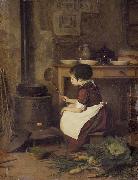 |
Pierre Edouard Frere
|
|
(1819-1886), French painter, studied under Hippolyte Delaroche, entered the cole des Beaux-Arts in 1836 and exhibited first at the Salon in 1843. The marked sentimental tendency of his art makes us wonder at John Ruskin's enthusiastic eulogy which finds in Frere's work the depth of William Wordsworth, the grace of Joshua Reynolds, and the holiness of Fra Angelico. What we can admire in his work is his accomplished craftsmanship and the intimacy and tender homeliness of his conception. Among his chief works are the two paintings, Going to School and Coming from School, The Little Glutton (his first exhibited picture) and L'Exercice (in the 19th century this work was in John Jacob Astor's collection). A journey to Egypt in 1860 resulted in a small series of Orientalist subjects, but the majority of Frere's paintings deal with the life of the kitchen, the workshop, the dwellings of the humble, and mainly with the pleasures and little troubles of the young, which the artist brings before us with humor and sympathy. He was one of the most popular painters of domestic genre in the middle of the 19th century. |
|
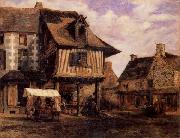 |
Pierre etienne theodore rousseau
|
|
Paris 1812-Barbizon 1867
French painter of the Barbizon school, was born in Paris, of a bourgeois family which included one or two artists.At first he received a business training, but soon displayed aptitude for painting. Although his father regretted the decision at first, he became reconciled to his son leaving business, and throughout the artist's career (for he survived his son) was a sympathizer with him in all his conflicts with the Paris Salon authorities. Theodore Rousseau shared the difficulties of the romantic painters of 1830 in securing for their pictures a place in the annual Paris exhibition. The whole influence of the classically trained artists was against them, and not until 1848 was Rousseau adequately presented to the public. He had exhibited one or two unimportant works in the Salon of 1831 and 1834, but in 1836 his great work "La descente des vaches" was rejected by the vote of the classic painters; and from then until after the revolution of 1848 he was persistently refused. He was not without champions in the press, and under the title of "le grand refus" he became known through the writings of Thor, the critic who afterwards resided in England and wrote under the name of Burger. During these years of artistic exile Rousseau produced some of his finest pictures: "The Chestnut Avenue", "The Marsh in the Landes" (now in the Louvre), "Hoar-Frost" (now in America); and in 1851, after the reorganization of the Salon in 1848, he exhibited his masterpiece, "The Edge of the Forest" (also in the Louvre), a picture similar in treatment to, but slightly varied in subject from, the composition called "A Glade in the Forest of Fontainebleau", in the Wallace Collection at Hertford House, London. Up to this period Rousseau had lived only occasionally at Barbizon, but in 1848 he took up his residence in the forest village, and spent most of his remaining days in the vicinity. He was now at the height of his artistic power, and was able to obtain fair sums for his pictures (but only about one-tenth of their value thirty years after his death), and his circle of admirers increased. He was still ignored by the authorities, for while Narcisse Virgilio Diaz was made Chevalier of the Legion of Honour in 1851, Rousseau was left undecorated at this time, but was nominated shortly afterwards. At the Exposition Universelle of 1853, where all Rousseau's rejected pictures of the previous twenty years were gathered together, his works were acknowledged to form one of the finest of the many splendid groups there exhibited. But during his lifetime Rousseau never really conquered French taste, and after an unsuccessful sale of his works by auction in 1861, |
|
|
|
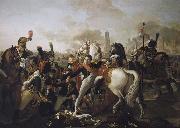 |
Pierre Gautherot
|
|
painted Napoleon Ier, blesse au pied devant Ratisbonne, est soigne par le chirurgien Yvan, 23 avril 1809 |
|
|
|
|
|
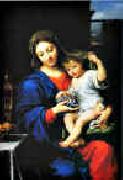 |
Pierre Mignard
|
|
French Baroque Era Painter, 1612-1695
Pierre Mignard (7 novembre 1612 - May 30, 1695), called "Le Romain" to distinguish him from his brother Nicolas, was a French painter. He was born at Troyes, and came of a family of artists; he also needs to be distinguished from his nephew Pierre (1640-1725), often called "Pierre II" or "Le Chevalier".
In 1630 he left the studio of Simon Vouet for Italy, where he spent twenty-two years, and made a reputation which brought him a summons to Paris. Successful with his portrait of the king, and in favour with the court, Mignard pitted himself against Le Brun, declined to enter the Academy of which he was the head, and made himself the centre of opposition to its authority. The history of this struggle is most important, because it was identical, as long as it lasted, with that between the old gilds of France and the new body which Colbert, for political reasons, was determined to support..
Portrait of Louise de Kerouaille, Duchess of Portsmouth. Wikimedia Commons has media related to: Pierre Mignard
Shut out, in spite of the deserved success of his decorations of the cupola of Val de Grace (1664), from any great share in those public works, the control of which was the attribute of the new Academy, Mignard was chiefly active in portraiture. Turenne, Moliere, Bossuet, Maintenon (Louvre), La Valliere, Sevigne, Montespan, Descartes (Castle Howard), all the beauties and celebrities of his day, sat to him. His readiness and skill, his happy instinct for grace of arrangement, atoned for want of originality and real power.
With the death of Le Brun (1690) the situation changed. Mignard deserted his allies, and succeeded to all the posts held by his opponent. These late honours he did not long enjoy. In 1695 he died whilst about to commence work on the cupola of the Invalides. His best compositions have been engraved by Audran, Edelinck, Masson, Poilly and others.
There is a good selection of works by Pierre, Nicolas, and Pierre II in Avignon at the Mus??e Calvet. The Courtauld Institute of Art (London), Harvard University Art Museums, the Hermitage Museum, the Honolulu Academy of Arts, Kunst Indeks Danmark, the Louvre, Mus??e d'art et d'histoire (Geneva), Mus??e des Augustins (Toulouse, France), Mus??e Ingres (Montauban, France), Museo Lombardi (Parma, Italy), the Museum of Fine Arts, Houston, the National Gallery, London, the National Portrait Gallery, London, the North Carolina Museum of Art, the Portland Art Museum and Versailles are among the public collections holding works by Pierre Mignard |
|
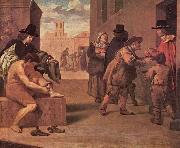 |
Pierre Montallier
|
|
(c. 1643 - 15 October 1697) was a French painter.[1] He died in Paris.
|
|
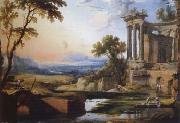 |
Pierre Patel
|
|
French Baroque Era Painter, ca.1605-1676
He dedicated himself exclusively to the art of landscape painting, and it is presumed that he spent his entire career in Paris, as there is no evidence to support claims that he went to Italy. In 1633-4 he was admitted to the guild of St Germain-des-Pr?s and in 1635 was admitted to the Acad?mie de Saint-Luc. In 1651 he took part in a vain attempt to merge the Acad?mie Royale and the Acad?mie de Saint-Luc, after which he remained loyal to the latter. |
|
|
|
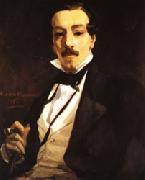 |
Pierre Puvis de Chavannes
|
|
1824-1898
French
Pierre Puvis de Chavannes Art Galleries
Born in Lyons on Dec. 14, 1824, Pierre Puvis de Chavannes belonged to the generation of Gustave Courbet and ??douard Manet, and he was fully aware of their revolutionary achievements. Nevertheless, he was drawn to a more traditional and conservative style. From his first involvement with art, which began after a trip to Italy and which interrupted his intention to follow the engineering profession that his father practiced, Puvis pursued his career within the scope of academic classicism and the Salon. Even in this chosen arena, however, he was rejected, particularly during the 1850s. But he gradually won acceptance. By the 1880s he was an established figure in the Salons, and by the 1890s he was their acknowledged master.
In both personal and artistic ways Puvis career was closely linked with the avant-grade. In the years of his growing public recognition, when he began to serve on Salon juries, he was consistently sympathetic to the work of younger, more radical artists. Later, as president of the Societe Nationale des Beaux-Arts - the new Salon, as it was called - he was able to exert even more of a liberalizing influence on the important annual exhibitions.
Puvis sympathy to new and radical artistic directions was reflected in his own painting. Superficially he was a classicist, but his personal interpretation of that style was unconventional. His subject matter - religious themes, allegories, mythologies, and historical events - was clearly in keeping with the academic tradition. But his style eclipsed his outdated subjects: he characteristically worked with broad, simple compositions, and he resisted the dry photographic realism which had begun to typify academic painting about the end of the century. In addition, the space and figures in his paintings inclined toward flatness, calling attention to the surface on which the images were depicted. These qualities gave his work a modern, abstract look and distinguished it from the sterile tradition to which it might otherwise have been linked.
Along with their modern, formal properties, Puvis paintings exhibited a serene and poetic range of feeling. His figures frequently seem to be wrapped in an aura of ritualistic mystery, as though they belong in a private world of dreams or visions. Yet these feelings invariably seem fresh and sincere. This combination of form and feeling deeply appealed to certain avant-garde artists of the 1880s and 1890s. Although Puvis claimed he was neither radical nor revolutionary, he was admired by the symbolist poets, writers, and painters - including Paul Gauguin and Maurice Denis - and he influenced the neoimpressionist painter Georges Seurat.
During his mature career Puvis executed many mural paintings. In Paris he did the Life of St. Genevieve (1874-1878) in the Panth??on and Science, Art, and Letters (1880s) in the Sorbonne. In Lyons he executed the Sacred Grove, the Antique Vision, and Christian Inspiration (1880s) in the Mus??e des Beaux-Arts. He painted Pastoral Poetry (1895-1898) in the Boston Public Library. These commissions reflect the high esteem with which Puvis was regarded during his own lifetime. Among his most celebrated oil paintings are Hope (1872) and the Poor Fisherman (1881). He died in Paris on Oct. 10, 1898. |
|
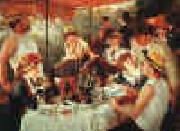 |
Pierre Renoir
|
|
French Impressionist Painter, 1841-1919
Pierre-Auguste Renoir (February 25, 1841?CDecember 3, 1919) was a French artist who was a leading painter in the development of the Impressionist style. As a celebrator of beauty, and especially feminine sensuality, it has been said that "Renoir is the final representative of a tradition which runs directly from Rubens to Watteau".
Renoir's paintings are notable for their vibrant light and saturated color, most often focusing on people in intimate and candid compositions. The female nude was one of his primary subjects. In characteristic Impressionist style, Renoir suggested the details of a scene through freely brushed touches of color, so that his figures softly fuse with one another and their surroundings.
His initial paintings show the influence of the colorism of Eugene Delacroix and the luminosity of Camille Corot. He also admired the realism of Gustave Courbet and Edouard Manet, and his early work resembles theirs in his use of black as a color. As well, Renoir admired Edgar Degas' sense of movement. Another painter Renoir greatly admired was the 18th century master François Boucher.
A fine example of Renoir's early work, and evidence of the influence of Courbet's realism, is Diana, 1867. Ostensibly a mythological subject, the painting is a naturalistic studio work, the figure carefully observed, solidly modeled, and superimposed upon a contrived landscape. If the work is still a 'student' piece, already Renoir's heightened personal response to female sensuality is present. The model was Lise Tr??hot, then the artist's mistress and inspiration for a number of paintings.
In the late 1860s, through the practice of painting light and water en plein air (in the open air), he and his friend Claude Monet discovered that the color of shadows is not brown or black, but the reflected color of the objects surrounding them. Several pairs of paintings exist in which Renoir and Monet, working side-by-side, depicted the same scenes (La Grenouill??re, 1869).
One of the best known Impressionist works is Renoir's 1876 Dance at Le Moulin de la Galette (Le Bal au Moulin de la Galette). The painting depicts an open-air scene, crowded with people, at a popular dance garden on the Butte Montmartre, close to where he lived.
On the Terrace, oil on canvas, 1881, Art Institute of ChicagoThe works of his early maturity were typically Impressionist snapshots of real life, full of sparkling colour and light. By the mid 1880s, however, he had broken with the movement to apply a more disciplined, formal technique to portraits and figure paintings, particularly of women, such as The Bathers, which was created during 1884-87. It was a trip to Italy in 1881, when he saw works by Raphael and other Renaissance masters, that convinced him that he was on the wrong path, and for the next several years he painted in a more severe style, in an attempt to return to classicism. This is sometimes called his "Ingres period", as he concentrated on his drawing and emphasized the outlines of figures.
After 1890, however, he changed direction again, returning to the use of thinly brushed color which dissolved outlines as in his earlier work. From this period onward he concentrated especially on monumental nudes and domestic scenes, fine examples of which are Girls at the Piano, 1892, and Grandes Baigneuses, 1918-19. The latter painting is the most typical and successful of Renoir's late, abundantly fleshed nudes.
A prolific artist, he made several thousand paintings. The warm sensuality of Renoir's style made his paintings some of the most well-known and frequently-reproduced works in the history of art.. |
|
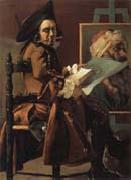 |
Pierre Subleyras
|
|
1699-1749
French painter, draughtsman and printmaker, active in Italy. He was one of the foremost French painters of portraits and religious compositions of the first half of the 18th century. From 1728 he lived in Rome, first as a student and then as an independent master working principally for the religious orders. |
|
|
|
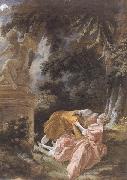 |
Pierre-Antoine Baudouin
|
|
French Painter, 1723-1769
French painter. A pupil of Francois Boucher, whose younger daughter he married in 1758, he specialized in miniatures painted in gouache, which he first exhibited at the Salon of 1761. He was received as a member of the Acad?mie Royale in 1763 with a small gouache of a historical subject, Phryne Accused of Impiety before the Areopagite (Paris, Louvre), and he later painted illustrations of biblical episodes. However, he made his name as a painter of libertine scenes in contemporary settings, which he exhibited regularly at the Salon from 1763 until 1769. Some of his work is directly inspired by Boucher's scenes of pastoral love, but the ostensibly moral themes and careful attention to detail of such paintings as the Modest Model (exh. Salon 1769; Washington, DC, N.G.A.) demonstrate that he was also influenced by Jean-Baptiste Greuze. His pictures were condemned for their immorality, both by the Archbishop of Paris, who in 1763 and 1765 ordered that works by Baudouin be withdrawn from the Salon, and also by Denis Diderot and other critics who accused him of pandering to the decadent taste of his patrons. Nevertheless, Baudouin was one of the most popular artists of the last decades of the ancien regime. |
|
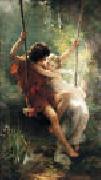 |
Pierre-Auguste Cot
|
|
French
1837-1883
Pierre-Auguste Cot Locations
He was born in B??darieux, and initially studied at l Ecole des Beaux-Arts in Toulouse before going to Paris. He studied under Leon Cogniet, Alexandre Cabanel and William-Adolphe Bouguereau. From the 1870s, his popularity grew quickly. In 1874 he was made Chevalier of the Legion of Honour. He created several works of lasting popularity, including Le Printemps, featuring two young lovers sitting upon a swing, and The Storm. Both these paintings were until recently on display at the Metropolitan Museum of Art in New York City; The Storm belongs to the museum while Le Printemps is owned privately.
Cot also was renowned for his portraits, which made up the majority of his work. The more enduring figurative work, such as The Storm, is comparatively rare. |
|
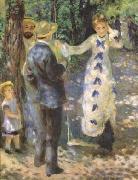 |
Pierre-Auguste Renoir
|
|
French Impressionist Painter, 1841-1919
French painter, printmaker and sculptor. He was one of the founders and leading exponents of IMPRESSIONISM from the late 1860s, producing some of the movement's most famous images of carefree leisure. He broke with his Impressionist colleagues to exhibit at the Salon from 1878, and from c. 1884 he adopted a more linear style indebted to the Old Masters.
His critical reputation has suffered from the many minor works he produced during his later years. |
|
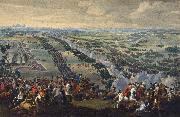 |
Pierre-Denis Martin
|
|
(b. ca. Paris 1663-d. Paris 1742) was a French painter, best known for his paintings of royal residences.
He was also known as "Martin le Jeune" ("Martin the Young") or as "Martin des Gobelins" (because he was employed at the Gobelins Manufactory).
|
|
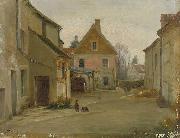 |
Pierre-edouard Frere
|
|
(1819 - 1886), French painter, studied under Hippolyte Delaroche, entered the e - ole des Beaux-Arts in 1836 and exhibited first at the Salon in 1843. The marked sentimental tendency of his art makes us wonder at John Ruskin's enthusiastic eulogy which finds in Frere's work the depth of William Wordsworth, the grace of Joshua Reynolds, and the holiness of Fra Angelico. What we can admire in his work is his accomplished craftsmanship and the intimacy and tender homeliness of his conception. Among his chief works are the two paintings, Going to School and Coming from School, The Little Glutton (his first exhibited picture) and L'Exercice (in the 19th century this work was in John Jacob Astor's collection). A journey to Egypt in 1860 resulted in a small series of Orientalist subjects, but the majority of Frere's paintings deal with the life of the kitchen, the workshop, the dwellings of the humble, and mainly with the pleasures and little troubles of the young, which the artist brings before us with humor and sympathy. He was one of the most popular painters of domestic genre in the middle of the 19th century.
|
|
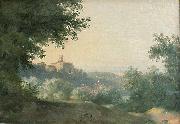 |
Pierre-Henri de Valenciennes
|
|
(December 6, 1750 - February 16, 1819) was a French painter.
Valenciennes worked in Rome from 1778 to 1782, where he made a number of landscape studies directly from nature, sometimes painting the same set of trees or house at different times of day.He theorized on this idea in Advice to a Student on Painting, Particularly on Landscape (1800), developing a concept of a "landscape portrait" in which the artist paints a landscape directly while looking upon it, taking care to capture its particular details.Although he spoke of this as a type of painting mainly of interest to "amateurs", as distinguished from the higher art of the academies, he found it of great interest, and of his own works the surviving landscape portraits have been the most noted by later commentators. He in particular urged artists to capture the distinctive details of a scene's architecture, dress, agriculture, and so on, in order to give the landscape a sense of belonging to a specific place; in this he probably influenced other French artists active in Italy who took an anthropological approach to painting rural areas and customs, such as Hubert Robert, Pierre-Athanase Chauvin and Achille-Etna Michallon. |
|
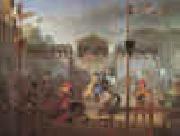 |
Pierre-Henri Revoil
|
|
1776-1824
French
Pierre Henri Revoil Gallery
Pierre R??voil (12 June 1776, Lyon - 19 March 1842, Paris) is a French painter of the Troubadour style. He was the elder brother of the poet Louise Colet and friend of François Fleury-Richard. |
|
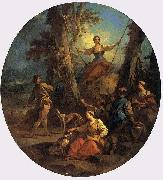 |
Pierre-Jacques Cazes
|
|
(1676-1754) was a French historical painter, known as the teacher of, among others, Chardin. In 1703, he became part of the Academie, was named as director in 1743 and chancellor in 1746. He also worked in the Galerie d'Apollon in the Louvre in 1727 and produced a large number of religious paintings for churches in Paris and Versailles. His historical painting is in the same academic tradition as the French painters Charles Le Brun and Charles de Lafosse. He also painted paintings with mythological motifs and genre scenes. A portrait the artist wearing a wig and holding a portfolio was presented to the Academie Royale in 1734 by Chardin's friend Joseph Aved.
|
|
|
|
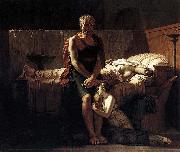 |
Pierre-Narcisse Guerin
|
|
(13 May 1774 - 6 July 1833) was a French painter.
Guerin was born in Paris.
A pupil of Jean-Baptiste Regnault, he carried off one of the three grands prix offered in 1796, in consequence of the competition not having taken place since 1793. In 1799, his painting Marcus Sextus (Louvre) was exhibited at the Salon and excited wild enthusiasm. Part of this was due to the subject - a victim of Sulla's proscription returning to Rome to find his wife dead and his house in mourning - in which an allusion was found to the turmoil of the French Revolution.
Guerin on this occasion was publicly crowned by the president of the Institute, and went to Rome to study under Joseph-Benoît Suvee. In 1800, unable to remain in Rome on account of his health, he went to Naples, where he painted the Grave of Amyntas. In 1802 Guerin produced Phaedra and Hippolytus (Louvre); in 1810, after his return to Paris, he again achieved a great success with Andromache and Pyrrhus (Louvre); and in the same year also exhibited Cephalus and Aurora (Louvre) and Bonaparte and the Rebels of Cairo (Versailles). These paintings suited the popular taste of the First Empire, being highly melodramatic and pompously dignified.
The Restoration brought to Guerin fresh honours; he had received from the first consul in 1803 the cross of the Legion of Honour, and in 1815 Louis XVIII named to the Academie des Beaux-Arts. His style changed to accord with popular taste. In Aeneas Relating to Dido the Disasters of Troy (Louvre), Guerin adopted a more sensuous, picturesque style.
Guerin was commissioned to paint for the Madeleine a scene from the history of St Louis, but his health prevented him from accomplishing what he had begun, and in 1822 he accepted the post of director of the French Academy in Rome, which in 1816 he had refused. On returning to Paris in 1828, Guerin, who had previously been made chevalier of the order of St. Michel, was ennobled. He now attempted to complete Pyrrhus and Priam, a work which he had begun at Rome, but in vain; his health had finally broken down, and in the hope of improvement he returned to Italy with Horace Vernet. Shortly after his arrival at Rome Baron Guerin died, on the 6th of July 1833, and was buried in the church of La Trinite de Monti by the side of Claude Lorrain.
|
|
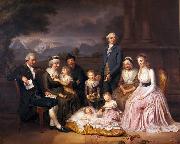 |
Pierre-Nicolas Legrand
|
|
(Pont-l'Éveque, 1758 - Bern, 1829) was a French painter.
Pupil of Descamps at the ole des Beaux-Arts de Rouen, along with Beljambe and Lequeu, Legrand won a second extraordinary prize in drawing, aged only 15. In 1782, he went to the ole des Beaux-Arts de Paris.
Circa 1794, Legrand de Serant departed for Bern, where he produced a variety of drawings for local notabilities and illustrated a novel by Isabelle de Charriere.
Legrand de Serant was a member of the Academie de Lille.
|
|
|
|
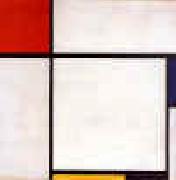 |
Piet Mondrian
|
|
Dutch
1872-1944
Piet Mondrian Location
was a Dutch painter.
He was an important contributor to the De Stijl art movement and group, which was founded by Theo van Doesburg. He evolved a non-representational form which he termed Neo-Plasticism. This consisted of a grid of vertical and horizontal black lines and the use of the three primary colours.
When 47-year-old Piet Mondrian left his artistically conservative native Holland for unfettered Paris for the second and last time in 1919, he set about at once to make his studio a nurturing environment for paintings he had in mind that would increasingly express the principles of Neo-Plasticism about which he had been writing for two years. To hide the studio's structural flaws quickly and inexpensively, he tacked up large rectangular placards, each in a single color or neutral hue. Smaller colored paper squares and rectangles, composed together, accented the walls. Then came an intense period of painting. Then again he addressed the walls, repositioning the colored cutouts, adding to their number, altering the dynamics of color and space, producing new tensions and equilibrium. Before long, he had established a creative schedule in which a period of painting took turns with a period of experimentally regrouping the smaller papers on the walls, a process that directly fed the next period of painting. It was a pattern he followed for the rest of his life, through wartime moves from Paris to London??s Hampstead in 1938 and 1940, across the Atlantic to Manhattan.
At 71 in the fall of 1943, Mondrian moved into his second and final New York studio at 15 East 59th Street, and set about again to create the environment he had learned over the years was most congenial to his modest way of life and most stimulating to his art. He painted the high walls the same off-white he used on his easel and on the seats, tables and storage cases he designed and fashioned meticulously from discarded orange and apple-crates. He glossed the top of a white metal stool in the same brilliant primary red he applied to the cardboard sheath he made for the radio-phonograph that spilled forth his beloved jazz from well-traveled records, Visitors to this last studio seldom saw more than one or two new canvases, but found, often to their astonishment, that eight large compositions of colored bits of paper he had tacked and re-tacked to the walls in ever-changing relationships constituted together an environment that, paradoxically and simultaneously, was both kinetic and serene, stimulating and restful. It was the best space, Mondrian said, that he had ever inhabited. Tragically, he was there for only a few months: he died of pneumonia in February 1944. |
|
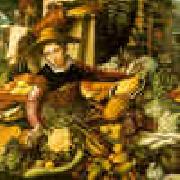 |
Pieter Aertsen
|
|
1508-1575
Flemish
Pieter Aertsen Galleries
Dutch painter and draughtsman, active also in the southern Netherlands. He probably trained in his native Amsterdam but early on moved to Antwerp, where he enrolled in the Guild of St Luke as a master in 1535. In 1542 he was granted citizenship of the city. Among his pupils in Antwerp were Johannes Stradanus and later Joachim Beuckelaer, a cousin of the artist wife and his most loyal follower. The earliest known work by Aertsen is a triptych with the Crucifixion (c. 1545-6; Antwerp, Maagdenhuismus.) for the van den Biest Almshouse in Antwerp. From 1550 Aertsen development can be traced through a large number of signed and dated paintings. Religious works, mostly intended for churches, must have formed an important part of Aertsen output. His early paintings seem to have been strongly influenced by other Antwerp artists, as can be seen in the van den Biest triptych, where the figures are close to those in Jan Sanders van Hemessen background scenes. Van Hemessen influence is also strong in the pair of triptychs showing the Seven Sorrows of the Virgin and the Seven Joys of the Virgin (the latter dated 1554; both Zoutleeuw, St Leonard).
|
|
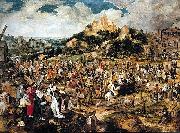 |
Pieter Balten
|
|
Pieter Balten (born ca. 1525 in Antwerp - died 1584 in Antwerp) was a Flemish Renaissance painter.
According to Karel van Mander he became a member of the Guild of St. Luke in 1559 and was a follower of Pieter Bruegel the Elder. He was a good poet and rederijker, who collaborated from time to time with Cornelis Ketel. |
|
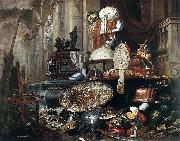 |
Pieter Boel
|
|
(1626-1674) was a Flemish Baroque painter who specialised in lavish still lifes.
Boel was born in Antwerp. He probably went to Italy in 1650. In 1668, he worked for Charles Le Brun (1619-1690) in his first tapestry making studio. According to Arnold Houbraken, whose source was his picture in Cornelis de Bie's book Het Gulden Cabinet, he specialized in painting animals. He died in Paris. |
|
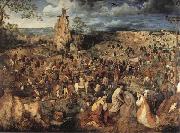 |
Pieter Bruegel
|
|
c.1525-69
Greatest Netherlandish painter of the 16th century. Not much is known of his early life, but in 1551 he set off for Italy, where he produced his earliest signed painting, Landscape with Christ and the Apostles at the Sea of Tiberias (c. 1553). Returning to Flanders in 1555, he achieved some fame with a series of satirical, moralizing prints in the style of Hiëronymus Bosch, commissioned by an Antwerp engraver. He is best known for his paintings of Netherlandish proverbs, seasonal landscapes, and realistic views of peasant life and folklore, but he also took a novel approach to religious subject matter, portraying biblical events in panoramic scenes, often viewed from above. He had many important patrons; most of his paintings were commissioned by collectors. In addition to many drawings and engravings, about 40 authenticated paintings from his enormous output have survived. |
|
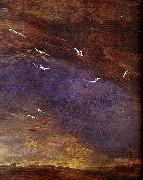 |
Pieter Bruegel the Elder
|
|
(Dutch pronunciation:c. 1525 - 9 September 1569) was a Flemish Renaissance painter and printmaker known for his landscapes and peasant scenes (Genre Painting). He is sometimes referred to as "Peasant Bruegel" to distinguish him from other members of the Brueghel dynasty, but is also the one generally meant when the context does not make clear which "Bruegel" is being referred to. From 1559 he dropped the 'h' from his name and started signing his paintings as Bruegel.
There are records that he was born in Breda, Netherlands, but it is uncertain whether the Dutch town of Breda or the Belgian town of Bree, called Breda in Latin, is meant. He was an apprentice of Pieter Coecke van Aelst, whose daughter Mayken he later married. He spent some time in France and Italy, and then went to Antwerp, where in 1551 he was accepted as a master in the painter's guild. He traveled to Italy soon after, and then returned to Antwerp before settling in Brussels permanently 10 years later. He received the nickname 'Peasant Bruegel' or 'Bruegel the Peasant' for his alleged practice of dressing up like a peasant in order to mingle at weddings and other celebrations, thereby gaining inspiration and authentic details for his genre paintings. He died in Brussels on 9 September 1569 and was buried in the Kapellekerk. He was the father of Pieter Brueghel the Younger and Jan Brueghel the Elder. Both became painters, but as they were very young children when their father died, it is believed neither received any training from him. |
|
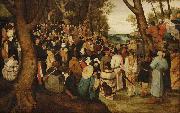 |
Pieter Brueghel the Younger
|
|
(1564 or 1565 - 10 October 1636) was a Flemish painter, known for numerous copies after his father Pieter Brueghel the Elder's paintings and nicknamed "Hell Brueghel" for his fantastic treatments of fire and grotesque imagery.
Pieter Brueghel the Younger was the oldest son of the famous sixteenth-century Netherlandish painter Pieter Brueghel the Elder (known as "Peasant Brueghel") and Mayken Coecke van Aelst. His father died in 1569, when Pieter the younger was only five years old. Then, following the death of his mother in 1578, Pieter, along with his brother Jan Brueghel the Elder ("Velvet Brueghel") and sister Marie, went to live with their grandmother Mayken Verhulst (widow of Pieter Coecke van Aelst). She was an artist in her own right, and according to Carel van Mander, possibly the first teacher of the two sons. The family moved to Antwerp sometime after 1578 and Pieter possibly entered the studio of the landscape painter Gillis van Coninxloo (1544 - 1607). In the 1584/1585 registers of Guild of Saint Luke, "Peeter Brugel" is listed as an independent master. On 5 November 1588 he married Elisabeth Goddelet, and the couple had seven children.
He painted landscapes, religious subjects and fantasy paintings. For this last category he often made use of fire and grotesque figures, leading to his nickname "Hell Brueghel".
Apart from these paintings of his own invention, Pieter Brueghel the Younger also copied the works his father had created by using a technique called pouncing. His genre paintings of peasants lack Pieter the Elder's subtlety and humanism, and emphasize the picturesque
|
|
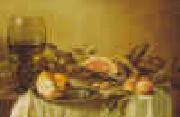 |
Pieter Claesz
|
|
Dutch 1597-1660 Pieter Claesz Locations
Dutch painter of German birth. He apparently spent his entire career in Haarlem, where he specialized in still-life paintings. Well over 100 works survive, dating from 1621 to 1660. Most of his pictures are dated and monogrammed PC. Since those initials were shared by the Antwerp still-life painter CLARA PEETERS, several attributions are disputed. |
|
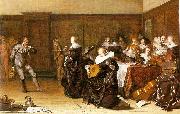 |
Pieter Codde
|
|
1599-1678
Dutch
Pieter Codde Locations
), was a Dutch painter of genre works and portraits, also known to be a poet. He is said to have studied with Frans Hals, but it is more likely that his training was with a portrait painter, Barent van Someren (1572 ?C 1632) or possibly with Cornelis van der Voort (1576 ?C 1624). His earliest work is known to be a piece from 1626, Portrait of a Young Man, now in the Ashmolean.
Most of his best remembered works were executed in Amsterdam and were small-scale paintings. They were distinctive in their silvery-gray tonalities, and many were musically themed, such as his first known genre work, Dancing Lesson (Louvre) from 1627, Musical Company of 1639, The Lute Player (Philadelphia Museum of Art) and, Concert, a piece now in the Uffizi Gallery. The other piece by Codde in the Uffizi is a genre work, Conversation. Codde also painted historical religious works, such as his Adoration of the Shepherds, from 1645, in the Rijksmuseum of Amsterdam.
Though it is unknown whether he studied with Frans Hals, his style is undoubtedly similar in some respects. He was commissioned in 1637 to complete an unfinished work of Hals, Officers of the Company of the Amsterdam Crossbow Civic Guard Under Captain Reynier Reael and Lieutenant Cornelis Michielsz Blaeuw. While the choice of Codde to complete this work by Hals was not an obvious selection at the time, Codde work in the portrait matched the original so well that it is uncertain who painted what, although the Rijksmuseum, which now houses the work, states that Codde??s style is recognizable smoother. |
|
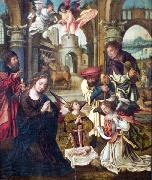 |
Pieter Coecke van Aelst
|
|
(August 14, 1502 - December 6, 1550) was a Flemish painter. He studied under Bernaert van Orley and later lived in Italy before entering the Antwerp Guild of painters in 1527. In 1533, he travelled to Constantinople for one year in a failed attempt to establish business connections for his tapestry works. Van Aelst established a studio in Brussels in 1544, where he created paintings and tapestries. His students include Gillis van Coninxloo, Willem Key, Hans Vredeman de Vries, Michiel Coxcie, and possibly Pieter Brueghel the Elder, who did eventually marry van Aelst's daughter, Mayken. His second wife, Mayken Verhulst, was an artist as well, and, according to Carel van Mander, the first teacher of her grandchildren, Pieter Brueghel the Younger and Jan Brueghel the Elder. He was also the uncle of Joachim Bueckelaer. Van Aelst's studio is also well known for its engraved works.
In particular, van Aelst is noted for his 1539 translation of Sebastiano Serlio's architectural treatise, Architettura, which is credited with having played a crucial role in spreading Renaissance ideas to the Low Countries and hastening the transition from the late Gothic style prevalent in the area at the time. He was in charge of the spectacular decorations for the 1549 Royal entry into Antwerp of Philip II of Spain, "the most famous entry of the century", according to Roy Strong.
|
|
 Mondriaan-665953.jpg) |
Pieter Cornelis (Piet) Mondriaan
|
|
(March 7, 1872?CFebruary 1, 1944) was a Dutch painter.
He was an important contributor to the De Stijl art movement and group, which was founded by Theo van Doesburg. He evolved a non-representational form which he termed Neo-Plasticism. |
|
|
|
|
|
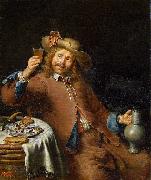 |
Pieter Cornelisz. van Slingelandt
|
|
(20 October 1640 - 7 November 1691) was a Dutch Golden Age painter.
According to Houbraken, his teacher was Gerard Dou, who he imitated so well that many of his works were later misattributed to him. According to Houbraken he was rather introverted and very methodical and conscientious, spending months on his works and striving for perfection. Houbraken especially liked a piece where a maid holds a mouse by the tail as a cat jumps for it.
Houbraken wrote that while Slingelandt was working on a family portrait for the gentleman Francois Meerman (1630-1672), |
|
 |
Pieter de Grebber
|
|
1600-1653
Dutch
Pieter de Grebber Gallery
Grebber was the son of Frans Pietersz de Grebber (1573?C1643), a painter and embroiderer in Haarlem, and would have been taught painting by his father and by Hendrick Goltzius. He was descended from a Catholic and artistic family (2 of his brothers, and his sister Maria, the mother-in-law of Gabriel Metsu, were known as painters). He was friendly with the priest and musicologist Jan Albertszoon Ban, and had a poem set to music by the Haarlem composer Cornelis Padbru??.
In 1618, father and son went to Antwerp and negotiated with Peter Paul Rubens over the sale of his painting "Daniel in the lions pit". It was then handed - via the English ambassador in the Republic, Sir Dudley Carleton - to king Charles I. Pieter got important commissions not only in Haarlem, but also from the stadholder Frederik Hendrik. As such, he worked with on the decoration of the Huis Honselaarsdijk in Naaldwijk and at the Paleis Noordeinde in Huis ten Bosch in the Hague. He painted altar pieces for churches in Flanders and hidden Catholic churches in the Republic. He may also have worked for Danish clients.
|
|
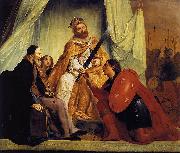 |
Pieter de Grebber
|
|
(c. 1600, Haarlem - 1652/3, Haarlem) was a Dutch Golden Age painter.
De Grebber was the oldest son of Frans Pietersz de Grebber (1573 - 1643), a painter and embroiderer in Haarlem, and the brother of the painters Maria and Albert. He learned to paint from his father and from Hendrick Goltzius. He was descended from a Catholic and artistic family and his sister Maria later became the mother-in-law of Gabriel Metsu. He was a friend of the priest and musicologist Jan Albertszoon Ban, and had a poem set to music by the Haarlem composer Cornelis Padbrue. In 1632 he became a member of the Haarlem Guild of St. Luke, but he had already been active as a painter for 10 years. His pupils were Gerbrand Ban, Nicolaes Pietersz Berchem, Egbert van Heemskerck, and Dirck Helmbreeker.
In 1618, father and son went to Antwerp and negotiated with Peter Paul Rubens over the sale of his painting "Daniel in the lions pit". It was then handed - via the English ambassador in the Republic, Sir Dudley Carleton - to king Charles I. Pieter got important commissions not only in Haarlem, but also from the stadholder Frederik Hendrik. As such, he worked on the decoration of the Huis Honselaarsdijk in Naaldwijk and at the Paleis Noordeinde in Huis ten Bosch in the Hague. He painted altar pieces for churches in Flanders and hidden Catholic churches in the Republic. He may also have worked for Danish clients.
Pieter remained single and lived from 1634 until his death at the Haarlem Beguinage.
|
|
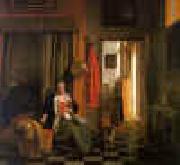 |
Pieter de Hooch
|
|
1629-1684
Dutch
Pieter de Hooch Galleries
De Hooch was born in Rotterdam to Hendrick Hendricksz de Hooch, a bricklayer, and Annetge Pieters, a midwife. He was the eldest of five children and outlived all of his siblings. He studied art in Haarlem under the landscape painter, Nicolaes Berchem. Beginning in 1650, he worked as a painter and servant for a linen-merchant and art collector named Justus de la Grange. His service for the merchant required him to accompany him on his travels to The Hague, Leiden, and Delft, to which he eventually moved. It is likely that de Hooch handed over most of his works to la Grange during this period in exchange for board and other benefits, as this was a common commercial arrangement for painters at the time, and a later inventory recorded that la Grange possessed eleven of his paintings.
De Hooch was married in Delft in 1654 to Jannetje van der Burch, by whom he fathered seven children. While in Delft, de Hooch is also believed to have learned from the painters Carel Fabritius and Nicolaes Maes, who were both early members of the Delft School. He became a member of the painters' guild of Saint Luke in 1655, and had moved to Amsterdam by 1661.
The early work of de Hooch, like most young painters of his time, was mostly composed of scenes of soldiers in stables and taverns, though he used these to develop great skill in light, color, and perspective rather than to explore an interest in the subject matter. After beginning his family in the mid-1650s, he switched his focus to domestic scenes and family portraits. His work showed astute observation of the mundane details of everyday life while also functioning as well-ordered morality tales. These paintings often exhibited a sophisticated and delicate treatment of light similar to those of Vermeer, who lived in Delft at the same time as de Hooch. 19th century art historians had assumed that Vermeer had been influenced by de Hooch's work, but the opposite is now believed.
|
|
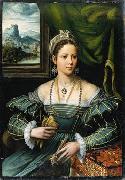 |
Pieter de Kempener
|
|
Pedro Campana (1503-1586) was a Flemish painter of the Renaissance period, mainly active in Italy and Spain. His actual name was Pieter de Kempeneer, translated into French as Champaigne, and was also known as Peter Van de Velde.
Born in Brussels, he trained there with Bernard Van Orley. His early life appears to have been spent in Italy, where he carefully studied the paintings of Raphael, and declared himself as his pupil. In 1530 he was at work at some scene-painting, representing a triumphal arch to be erected on the occasion of the coronation of Charles V, Holy Roman Emperor in Bologna, and he then left for Spain, on the advice, it is said, of Cardinal Domenico Grimani, and spent the rest of his life in that country, only returning to Brussels about 1563 or 1565.
Between 1537 and 1562 he was associated with Luis de Vargas and the Italian sculptor Torregiano in establishing a school of painting in Seville, which eventually became the academy of the place; amongst the pupils educated in it was Morales. He painted for the monastery of St. Mary of Grace, Church of Santa Cruz, in the city, an altar-piece representing the Descent from the Cross (1548), which is now in the cathedral, having been removed there when the church fell into ruins. There are other works by the same painter in Seville Cathedral, especially two representing the Purification of the Virgin and the Resurrection; and the various churches of the city, S. Isidoro, S. Pedro, S. Catalina, and S. Juan, all possess paintings by this artist. One of his last works was the restoration and repainting of a chapel belonging to Hernando de Jaen, an important resident of Seville. Murillo requested that he be buried near Campana's picture, and his burial took place in the Church of Santa Cruz, close underneath the Descent from the Cross, but the whole building was burned to the ground during the Napoleonic Wars, and the tomb perished. |
|
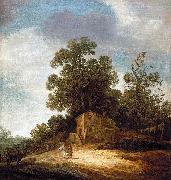 |
Pieter de Molijn
|
|
(6 April 1595 - 23 March 1661) was a Dutch Golden Age painter and engraver born in England.
He was baptized in the Dutch Reformed Austin Friars church in London. Little is known of his early training, but he probably traveled to Italy and in 1616 he became a member of the Haarlem Guild of St. Luke. He was a contemporary of Jacob Pinas. He married Geertuyt Huygen de Bie. During the years 1616-1627 he lived in Delft where he remarried after his first wife died. In the marriage notice, his wife Geertruyt de Roovere is from Amsterdam and he is from Delft.
De Molijn was possibly a student of Esaias van de Velde. He taught several students, including Gerard ter Borch, Jan Coelenbier, Allart van Everdingen, Christian de Hulst, Anthony Molijn, Jan Nose and Jan Wils.De Molijn was known for his landscapes, but he also made genre pieces, marine scenes, portraits, and architectural pieces. This type of oeuvre is typical for the Italian-bound artists of his day, who paid their way as a jack-of-all-trades. De Molijn died in Haarlem on 23 March 1661.
|
|
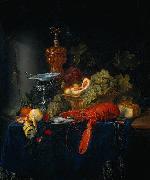 |
Pieter de Ring
|
|
(1615/1620 - 22 September 1660, Leiden) was a Dutch Golden Age painter of still lifes. became famous for his opulent, flashy still lifes or banquet pieces with fruit, a lobster, a goblet, shrimps, oysters, a rug and Chinese porcelain. His signature is often a painted ring or with the Latinised form of his name, P.Ab.Annulo.
De Ring was born either in Leiden, or in Ypres in Flanders, but there is no trace of his birth in the Leiden archives, and the Ypres Archives were destroyed in August 1914. Pieter de Ring started as a mason and painted still lifes in the evening. When the hall was filled with paintings he became a pupil of Jan Davidsz. de Heem, until 1635 living in Leiden. His father Daniel died in 1648; in 1657 his mother lived in Amsterdam. De Ring himself lived in a house at Hogewoerd.
There are no records in the Leiden Archive on his marriage or children. He appears not to have bought a house there nor wrote a will. What is known is that he became one of the founders a member and of the Guild of St. Luke in 1648, De Ring was buried in the Pieterskerk, Leiden on 22 September 1660 and taken to church from a house in the Nonnensteeg. If he had his studio there he probably had a view on the Leiden Academy building. If he lived on the east side of the alley he had a beautiful view on the Hortus Botanicus of Leiden, the work of Clusius. |
|
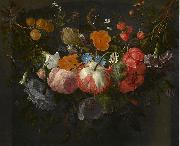 |
Pieter Gallis
|
|
(1633, Enkhuizen - 1697, Hoorn), was a Dutch Golden Age painter.
According to Houbraken, he painted as a hobby, since he earned his living as the director of the local pawn shop (Bank van Lening).He specialized in landscapes, flowers, fruit and other forms of still life. He was a very friendly man, especially to artists and art collectors.
He was active in Enkhuizen (and perhaps Amsterdam), in Purmerend from 1679-1683, and in Hoorn from 1683 until his death. |
|
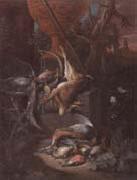 |
Pieter Gijsels
|
|
Flemish painter (b. 1621, Antwerpen, d. 1690, Antwerpen |
|
|

